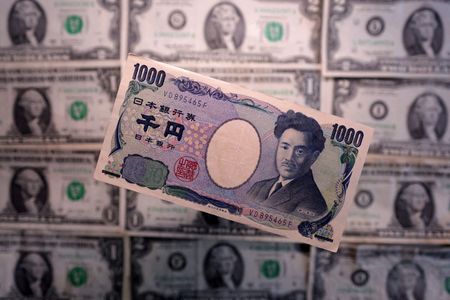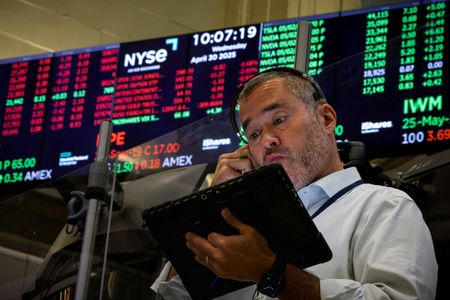By Rocky Swift
TOKYO (Reuters) – The dollar dipped on Friday, with investors nervous about chasing its recent rebound too much further ahead of important U.S. jobs data, but it remained set for a weekly rise against nearly all peers.
The risk-sensitive Aussie and kiwi dollars climbed in Asia trade as European and Asian shares continued a rally that began on Wall Street against the backdrop of updates from China and Japan on tariff discussions with the Donald Trump administration.
And that dollar selling then broadened out into other currencies with the greenback down 0.45% on the Japanese yen at 144.76, the euro up 0.35% at $1.1330 and China’s offshore yuan at a near six-month top of 7.225 per dollar.
Nonetheless, the U.S. dollar was still on track for a third straight weekly advance. Alongside U.S. Treasuries and shares, it has bounced from steep declines last month as President Donald Trump’s erratic tariff policies drove fears of a recession and sapped confidence in U.S. assets.
“The dollar has benefited from month-end flows,” said Kenneth Broux, head of corporate research FX and rates at Societe Generale.
He said the dollar had been supported earlier this week by the Bank of Japan’s dovishness on Thursday, as well as strong earnings reports from U.S. tech giants, the rally on Nasdaq and flows into U.S. equities.
“Maybe the whole ‘sell America’ story looked a little bit overdone. And we saw Japanese investors also buying the most foreign bonds in eight weeks, tempering expectations that everybody in the world is going to sell Treasuries,” Broux said.
Shaping moves on Friday, U.S. Secretary of State Marco Rubio told Fox News late on Thursday that talks with China will come up soon. His comments came on the heels of a Chinese state media report seen as a signal of Beijing’s openness to trade negotiations.
Beijing was “evaluating” an offer from Washington to hold talks over Trump’s tariffs, China’s Commerce Ministry said on Friday.
The China-exposed Australian dollar rose 0.77% to $0.6432.
Separately, Japan’s top trade negotiator, Ryosei Akazawa, said he deepened talks on trade, non-tariff measures and economic security cooperation with U.S. Treasury Secretary Scott Bessent in Washington on Thursday.
And Finance Minister Katsunobu Kato said Japan could use its $1 trillion-plus holdings of U.S. Treasuries as leverage in trade talks with Washington.
Market participants are now looking to the non-farm payrolls (NFP) report at 1230 GMT for an indication on when the Federal Reserve will resume cutting rates. Wall Street economists are forecasting 130,000 new jobs created last month, compared with a print of 228,000 seen in March.
Many investors expect Trump’s chaotic trade policy to hurt the U.S. economy, but until now it has been too early for this to be seen in hard economic data. It is likely too early for the payrolls to offer much more than a hint either, but it could help.
Societe Generale’s Broux said a number far from the consensus would actually be better, helping clarify whether the U.S. was heading for a recession, which would mean more Fed rate cuts, or would avoid a sharp slowdown.
In terms of currencies, “the question is whether we sell that dollar rally again, because that has been the modus operandi in FX now for a couple of weeks”, he said.
(Reporting by Rocky Swift and Vidya Ranganathan; Editing by Susan Fenton)










